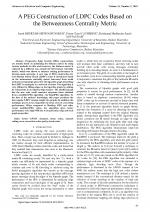| 2/2016 - 12 |
A PEG Construction of LDPC Codes Based on the Betweenness Centrality MetricBHURTAH-SEEWOOSUNGKUR, I. |
| Extra paper information in |
| Click to see author's profile in |
| Download PDF |
Author keywords
AWGN channels, block codes, channel coding, error correction codes, parity check codes
References keywords
codes(22), ldpc(18), algorithm(10), information(9), theory(8), communications(8), quasi(4), progressive(4), processing(4), growth(4)
Blue keywords are present in both the references section and the paper title.
About this article
Date of Publication: 2016-05-31
Volume 16, Issue 2, Year 2016, On page(s): 85 - 92
ISSN: 1582-7445, e-ISSN: 1844-7600
Digital Object Identifier: 10.4316/AECE.2016.02012
Web of Science Accession Number: 000376996100012
SCOPUS ID: 84974834729
Abstract
Progressive Edge Growth (PEG) constructions are usually based on optimizing the distance metric by using various methods. In this work however, the distance metric is replaced by a different one, namely the betweenness centrality metric, which was shown to enhance routing performance in wireless mesh networks. A new type of PEG construction for Low-Density Parity-Check (LDPC) codes is introduced based on the betweenness centrality metric borrowed from social networks terminology given that the bipartite graph describing the LDPC is analogous to a network of nodes. The algorithm is very efficient in filling edges on the bipartite graph by adding its connections in an edge-by-edge manner. The smallest graph size the new code could construct surpasses those obtained from a modified PEG algorithm - the RandPEG algorithm. To the best of the authors' knowledge, this paper produces the best regular LDPC column-weight two graphs. In addition, the technique proves to be competitive in terms of error-correcting performance. When compared to MacKay, PEG and other recent modified-PEG codes, the algorithm gives better performance over high SNR due to its particular edge and local graph properties. |
| References | | | Cited By |
Web of Science® Times Cited: 2 [View]
View record in Web of Science® [View]
View Related Records® [View]
Updated 2 weeks, 5 days ago
SCOPUS® Times Cited: 2
View record in SCOPUS® [Free preview]
View citations in SCOPUS® [Free preview]
[1] On the performance analysis of short LDPC codes, Medova, Luiza R., Rybin, Pavel S., Filatov, Ivan V., 2019 XVI International Symposium "Problems of Redundancy in Information and Control Systems" (REDUNDANCY), ISBN 978-1-7281-1944-1, 2019.
Digital Object Identifier: 10.1109/REDUNDANCY48165.2019.9003310 [CrossRef]
Disclaimer: All information displayed above was retrieved by using remote connections to respective databases. For the best user experience, we update all data by using background processes, and use caches in order to reduce the load on the servers we retrieve the information from. As we have no control on the availability of the database servers and sometimes the Internet connectivity may be affected, we do not guarantee the information is correct or complete. For the most accurate data, please always consult the database sites directly. Some external links require authentication or an institutional subscription.
Web of Science® is a registered trademark of Clarivate Analytics, Scopus® is a registered trademark of Elsevier B.V., other product names, company names, brand names, trademarks and logos are the property of their respective owners.
Faculty of Electrical Engineering and Computer Science
Stefan cel Mare University of Suceava, Romania
All rights reserved: Advances in Electrical and Computer Engineering is a registered trademark of the Stefan cel Mare University of Suceava. No part of this publication may be reproduced, stored in a retrieval system, photocopied, recorded or archived, without the written permission from the Editor. When authors submit their papers for publication, they agree that the copyright for their article be transferred to the Faculty of Electrical Engineering and Computer Science, Stefan cel Mare University of Suceava, Romania, if and only if the articles are accepted for publication. The copyright covers the exclusive rights to reproduce and distribute the article, including reprints and translations.
Permission for other use: The copyright owner's consent does not extend to copying for general distribution, for promotion, for creating new works, or for resale. Specific written permission must be obtained from the Editor for such copying. Direct linking to files hosted on this website is strictly prohibited.
Disclaimer: Whilst every effort is made by the publishers and editorial board to see that no inaccurate or misleading data, opinions or statements appear in this journal, they wish to make it clear that all information and opinions formulated in the articles, as well as linguistic accuracy, are the sole responsibility of the author.



